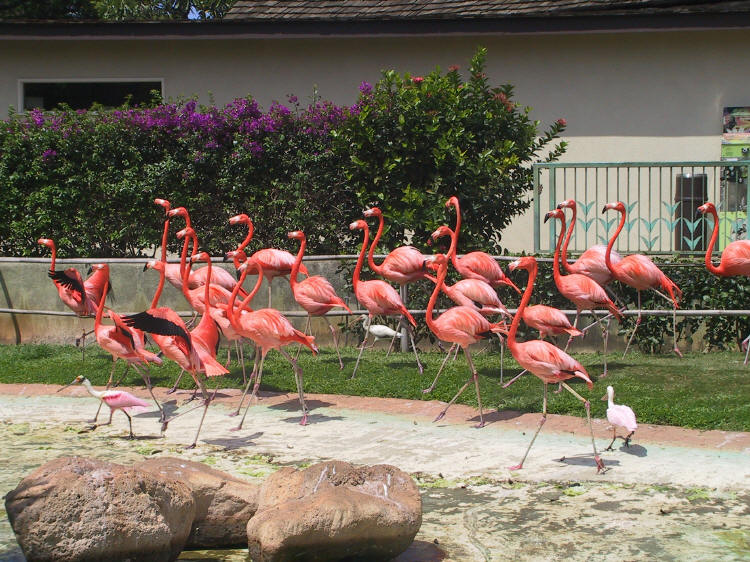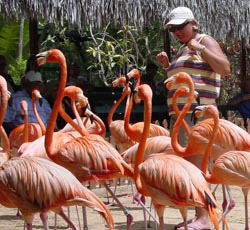
Interactions


It is a rarity to find breeding colonies of only a few birds. Caribbean Flamingos usually live in a colony with hundreds or even thousands of birds. Flamingos communicate with each other by various displays, synchronized postures and movements to facilitate breeding, see Reproduction to learn more about these breeding displays. Flamingos have also been known to fight with other flamingos as well. This may occur when a mating pair comes in contact with another mating pair. The male will become aggressive and proceed to protect the female. Flamingos will even chase after each other, use their bills to fight, or have a stand off with one another and make vocalizations. When birds sitting on high rise nests decide to fight each other, it can be dangerous and often it will end with the lose of an egg.

In the Bahamas on Great Inaqua, feral pigs prey on Caribbean Flamingos. However, since the Caribbean Flamingo occupies remote breeding sites, it makes it hard for land predators to feed on them regularly. Once the water levels are low, land predators are able to enter into the flamingos nesting grounds. This is exactly what the feral pig does. Another reason for the lack of predation on the Caribbean Flamingo is because its alkaline diet does not satisfy the needs of other animals.
Human destruction of the Caribbean Flamingo habitat has definitely had a negative effect on its breeding and feeding grounds. Road construction, the development of houses, and shipping docks have made the Caribbean Flamingo's habitat more accessible to humans. And In the wild, the mere sight of a tourist or photographer, may cause the flamingo to lose it young and its eggs. Desert irrigation along the coast has altered water levels and since the flamingo likes to live and breed in shallow waters this is big problem for the flamingos. Mining is another thing that has altered the flamingo's habitat. Many flamingos have also died from lead poisoning in the Yucatan Peninsula of Mexico from ingesting the lead bullets. In addition, humans have been known to use flamingos and their eggs for food. Flamingo eggs are a delicacy that are sold in local marketplaces. In ancient times, the Romans even ate flamingo tongues. Gross!

The Food Web
In the Food Web the Caribbean Flamingo is able to act as the primary consumer or the secondary consumer. If it feeds on algae or any plant material, it is acting as a primary consumer because it is feeding on something that can produce its own food by photosynthesis. If the flamingo feeds on a small fish that has eaten algae it is considered a secondary consumer. A flamingo may even provide food and energy for a tertiary consumer, like the feral pig.